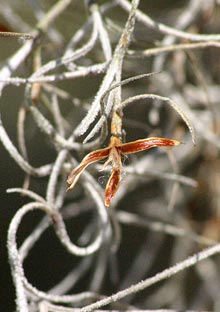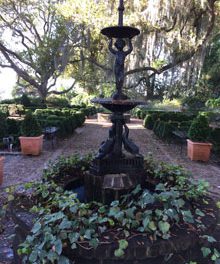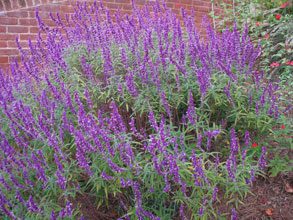 If you have any sense at all (as my mother used to say), you would never take a good long look at Spanish Moss, that great ghostly symbol of the Deep South, and have images of sweet Hawaiian fruit or brilliant-flowered house plants pop into your mind. That’s just crazy.
If you have any sense at all (as my mother used to say), you would never take a good long look at Spanish Moss, that great ghostly symbol of the Deep South, and have images of sweet Hawaiian fruit or brilliant-flowered house plants pop into your mind. That’s just crazy.
Well, maybe it’s not so crazy after all. All three are members of the Bromeliad family – the draping grey threads of Spanish Moss; the pineapple; and potted bromeliads found in garden centers and grocery stores year round, those plants with the intensely colored foliage and flower bracts.
All three are flowering plants. Although the sometimes garish bromeliads in pots seem to be showing off their flowers, the actual flowers are often much smaller than the colorful bracts hiding them. Pineapple fruit forms from the hundreds of tiny flowers within the crown of the plant. And, believe it or not, Spanish Moss makes flowers, too – tiny flowers emerge from the axils where the grey threads branch.
Take a close look at Spanish Moss sometime, using a little hand magnifying glass; it gets really interesting. You may first notice that it actually is a green plant – the grey color comes from the very tiny scales covering the outside of each green thread-like leaf. When the moss is wet, the grey is minimized and the green is made more readily visible. You will likely find the seed cases more often than the flowers.
 Spanish Moss has a botanical name, of course – Tillandsia usneoides. One of my favorite flowering potted bromeliads is a close relative of Tillandsia, Billbergia nutans, popularly called “Queen’s Tears”.
Spanish Moss has a botanical name, of course – Tillandsia usneoides. One of my favorite flowering potted bromeliads is a close relative of Tillandsia, Billbergia nutans, popularly called “Queen’s Tears”.
Some fifteen or twenty years ago I got a Queen’s Tears bromeliad in Florida, struck by the astonishing neon colors of its flower and bract. I assumed it would require the usual coddling of most tropical houseplants, and it certainly responded well to windowsill care. Eventually I knew I had to repot the thing, since it had grown so large. After making several windowsill sized plants, there were a number of leftovers; I simply potted these and left them outside during the warm weather. Some stayed in the yard in Beaufort, and I took some to the family farm several hours inland…and then I forgot all about them. Much to my surprise, several of the plants survived the winter in each place, although predictably the survivors were the ones in the most protected spots. The Queen’s Tears can easily survive a cool winter outside, if they are protected. Frost will damage or kill back much of the foliage, but the roots can survive if the central part of the plant stays alive. A freeze will likely kill it completely.
The reason I wanted to write about all these bromeliad relatives is that I have gotten several inquiries lately about what to do with those potted bromeliads after they’ve flowered. Everyone knows those blooms will last on the plant for months, but what do you do when they finally fade away, the bloom stalk dries brown, and then the leaves of the plant start looking pretty miserable. Is it going to die? Should I just throw it away?
Here’s what you do: pick up the potted bromeliad and look at it closely. See where the dead or dying bloom stalk goes down into the center of the leaves? Are the leaves still healthy, or have they started dying, too? They will die, you know, eventually. In fact, the entire plant will die after it has bloomed, but it may take six months or more for it to completely die back. This is good; this is the really exciting part.
After the stalk has died back a good bit, and maybe after the leaves have started to die back, take another close look at the base of the slowly dying plant. You may see a couple of greenish swellings coming off the base – sometimes I find just one, sometimes three or four. In time, these bumps become larger and, one day, you will notice that it’s a tiny baby plant! Or two! Or three! These will continue to grow on the dying mother plant, so long as you care for the plant as if you didn’t notice it’s dying. Eventually, after the mother plant has completely given up all its life-giving nutrients to its pups, the dried up leaves will pull off with a tug. At that point, you can carefully remove the pups and repot in their own little pots. Or you can do as I do: leave the little plants to grow as they are, making a little colony of bromeliads. This is how they grow in the wild. As one plant blooms and dies, two or more will take its place. They will bloom and die, leaving an ever larger clump to carry on. It’s amazing to see.
Each type of bromeliad will have its own method of reproducing itself. My Queen’s Tears plants send a small branching root off the mother plant, and this branching root sends up its own new plant. In a very short while I have a dozen or more plants in the pot. What a spectacular sight that makes when the blooms start in late winter!
So whenever you’re given one of those fancy blooming bromeliads, think of its delicious cousin, the pineapple. And remember that all that grey Spanish Moss hanging from your romantic live oaks is yet another cousin, another bromeliad.








